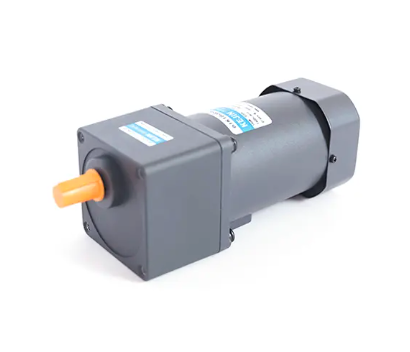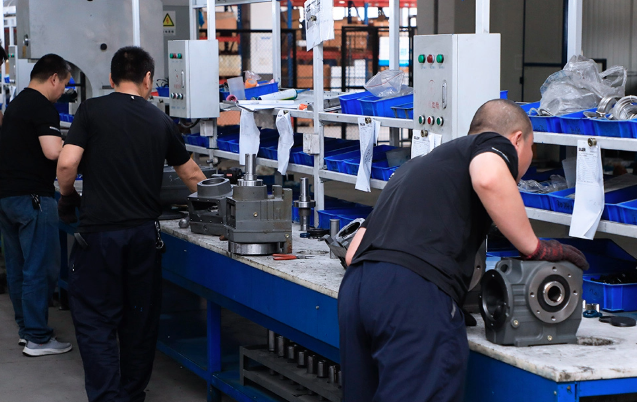- All
- Product Name
- Product Keyword
- Product Model
- Product Summary
- Product Description
- Multi Field Search


Views: 0 Author: Site Editor Publish Time: 2025-09-29 Origin: Site










Gearmotors are everywhere—hidden inside machines we use daily, from elevators and conveyor belts to medical scanners and robotics. A gearmotor combines a motor with a gearbox, creating a compact system that balances speed, torque, and efficiency. Choosing the right type depends on the application, because every design has its strengths.
In this guide, we’ll explore 8 types of gearmotors and their applications, breaking down how each works, what makes it unique, and where you’re most likely to find it. Whether you’re designing industrial equipment, working on automation, or just curious about engineering, this article will give you a clear, practical understanding of the gearmotor world.
A gearmotor combines a motor and a gearbox into one unit. The motor provides the power. The gearbox modifies torque and speed. Together, they deliver controlled motion. Gearmotors are used in industries, medical devices, robotics, and home appliances.
Why use a gearmotor?
Increase torque while reducing speed
Improve efficiency in small designs
Provide precise, reliable motion
Handle continuous or heavy-duty work
| Feature | Motor Only | Gearmotor |
|---|---|---|
| Torque output | Low | High |
| Speed control | Limited | Flexible |
| Efficiency | Varies | Optimized |
| Space saving | No | Yes |

Spur gearmotors are the most basic and widely used type. They employ straight-cut gears that mesh together on parallel shafts, making them simple in both design and operation. Because of their direct gear engagement, spur gearmotors are relatively easy to manufacture and maintain. However, their straightforward design also makes them noisier at higher loads or speeds compared to other gear types.
High efficiency at low to medium speeds
Easy to maintain and cost-effective
Can be noisy under heavy loads or at higher speeds
Spur gearmotors are commonly found in everyday machinery where cost-efficiency and reliability matter most. They are used in conveyor belts for moving materials at steady speeds, in printers for feeding paper smoothly, and in packaging machines where timing and precision are important. Although they may not be the quietest option, their simplicity makes them a dependable choice across many industries.
Helical gearmotors improve upon spur gears by cutting the gear teeth at an angle, which allows for smoother meshing. This design reduces noise and vibration while increasing the strength of the gear system. Helical gearmotors are widely chosen for long-running industrial applications where efficiency and durability are crucial.
Smooth and quiet power transmission
High load capacity due to angled tooth engagement
Excellent for continuous, long-duty cycles
Helical gearmotors are commonly used in elevators, where quiet and reliable operation is essential for passenger comfort. In automotive systems, they help drive components with consistent efficiency. Industrial machinery also relies heavily on helical gearmotors because of their ability to handle large loads while running for long hours without excessive wear.
Worm gearmotors consist of a worm screw that meshes with a worm wheel. This unique arrangement allows for high torque output in a compact design, making them ideal for space-saving applications. A key feature of worm gearmotors is their self-locking ability, which prevents reverse motion under load. However, they typically operate with lower efficiency compared to helical or planetary designs.
High torque in a compact size
Built-in self-locking function for safety
Lower efficiency and more heat generation
| Advantage | Limitation |
|---|---|
| Self-locking safety | Less efficient |
| Compact, high torque | Generates heat |
Worm gearmotors are widely used in gates, lifts, and hoists, where preventing backward motion is critical for safety. They are also a good fit for conveyor systems, especially when handling heavy loads on inclined surfaces. Additionally, tuning instruments and precision devices sometimes rely on worm gearmotors because of their ability to hold position securely without additional brakes.
Planetary gearmotors feature a central sun gear, multiple planet gears, and an outer ring gear. The load is distributed across several gear contacts, giving this type an outstanding torque-to-size ratio. Planetary gearmotors are compact, efficient, and durable, making them suitable for applications requiring precision and strength in limited space.
High torque density in a small package
Compact, durable, and highly efficient
Excellent for precise motion control
Planetary gearmotors dominate in robotics, where precise positioning and high torque are crucial for smooth movement. Aerospace systems also use them in actuators and control mechanisms because they deliver reliability under extreme conditions. In medical imaging equipment, planetary gearmotors enable precise movements of scanning arms and tables, ensuring accurate results without vibration or drift.
Bevel gearmotors employ gears that intersect, often at 90°, allowing torque to change direction. This right-angle configuration saves space while delivering high efficiency. Bevel gears are more complex to manufacture, which makes them more expensive, but they provide excellent durability under stress.
Space-saving right-angle configuration
High efficiency and durability
More costly due to complex gear design
Bevel gearmotors are used in printing machines, where precise direction changes are needed for paper handling. In mining equipment, they withstand heavy loads and demanding environments while maintaining efficiency. Agricultural machinery also benefits from bevel gearmotors, as they offer reliable torque transfer even when operating under dirt, dust, and uneven loading conditions.
Parallel shaft gearmotors have input and output shafts that run in parallel alignment. This arrangement makes them compact yet powerful, offering a good balance between efficiency and versatility. They are widely used in mid-range torque applications where space is limited.
Compact structure suitable for narrow spaces
High efficiency for continuous operation
Versatile performance across medium torque ranges
These gearmotors are frequently used in mixers and agitators, where consistent torque delivery ensures proper blending. Textile machines rely on parallel shaft gearmotors for steady fabric handling and precise motion. Conveyor drives also use them, especially when space constraints require a slim design without sacrificing efficiency.
Right-angle gearmotors are designed to redirect motion by 90°, making them ideal for compact installations. Depending on the design, they may incorporate bevel, hypoid, or worm gears. Their ability to fit into tight spaces without compromising torque makes them highly flexible in industrial systems.
Space-saving design ideal for small areas
Flexible integration with AC or DC motors
Effective in environments with restricted mounting options
Right-angle gearmotors are widely used in food processing lines, where hygiene and compact setups are important. Packaging systems also employ them to manage conveyors and machinery in limited spaces. In the automotive sector, they help power lifts and hoists where right-angle torque transfer is necessary for effective load handling.
DC gearmotors combine a DC motor with a gearbox, providing controlled, low-speed motion with high torque. They are lightweight, compact, and known for their excellent speed control. However, they usually deliver less power than AC gearmotors, which makes them more suitable for light to medium-duty applications.
Lightweight and compact construction
Precise and flexible speed control
Lower overall power output compared to AC gearmotors
DC gearmotors are common in electric wheelchairs, offering smooth and adjustable motion for user comfort. They also power many toys, giving them reliable yet safe movement. In small-scale automation projects, such as home robotics or automated blinds, DC gearmotors provide a balance of efficiency, affordability, and precise control.

| Gearmotor Type | Torque Output | Efficiency | Noise Level | Special Feature | Common Applications |
|---|---|---|---|---|---|
| Spur Gearmotor | Medium | High | Moderate | Simple, affordable | Printers, conveyors |
| Helical Gearmotor | High | High | Low | Smooth operation | Elevators, automotive |
| Worm Gearmotor | Very High | Low | Low | Self-locking | Gates, conveyors |
| Planetary Gearmotor | Very High | High | Moderate | Compact precision | Robotics, aerospace |
| Bevel Gearmotor | High | High | Moderate | Direction change | Mining, agriculture |
| Parallel Shaft | Medium-High | High | Moderate | Compact parallel | Mixers, conveyors |
| Right-Angle | Medium | Medium | Moderate | Space-saving 90° | Food processing, lifts |
| DC Gearmotor | Low-Medium | Medium | Low | Portable, precise | Toys, wheelchairs |
A gearmotor provides higher torque at lower speeds. It combines a motor and gearbox into one unit, saving space while improving efficiency.
Worm gearmotors and planetary gearmotors deliver the highest torque. Worm gearmotors also have a self-locking feature, while planetary gearmotors are compact and efficient.
Yes. Motors alone often run too fast and lack torque. Adding a gearbox makes the system more efficient for real-world applications like conveyors, lifts, or robotics.
Gearmotors are common in automation, automotive, food processing, packaging, mining, robotics, and medical equipment.
It depends on load, duty cycle, and maintenance. A well-maintained industrial gearmotor can last 10–20 years.
Choosing the right gearmotor depends on your application, desired torque, efficiency, and space limitations. From simple spur designs to advanced planetary systems, each type offers unique benefits. Whether you’re designing for heavy industry, robotics, or everyday automation, knowing these options ensures the right fit.
If you are looking for reliable, high-performance gearmotors, consider working with Qingdao Chinese Science Machinery Co., Ltd. With years of expertise and a wide product portfolio, they deliver solutions tailored to industries worldwide. Their gearmotors combine precision, durability, and innovation—backed by thoughtful after-sales service that ensures lasting performance and customer satisfaction.